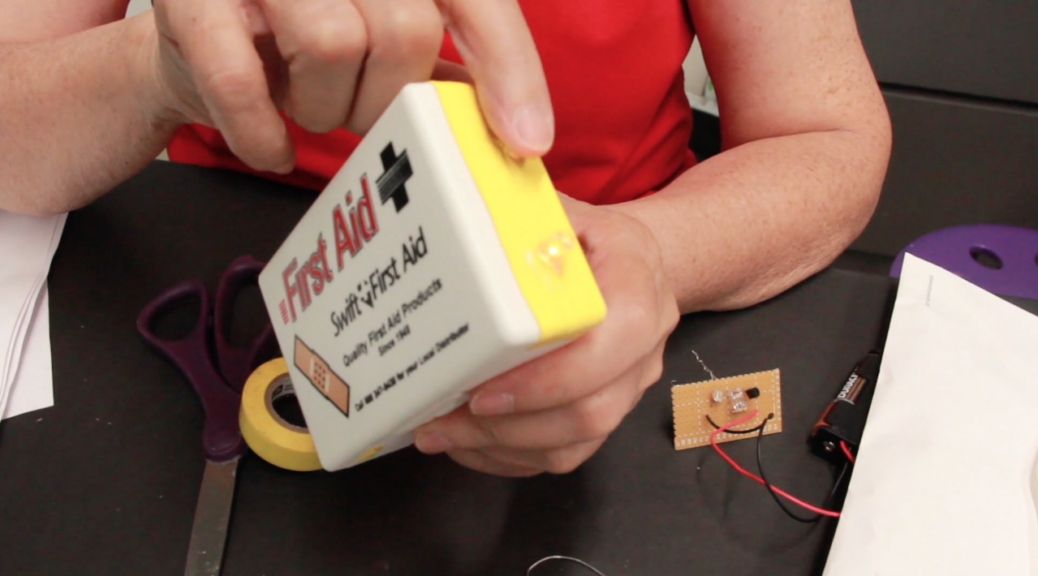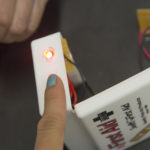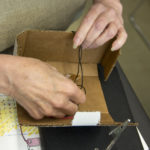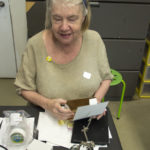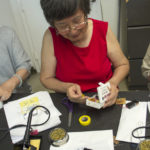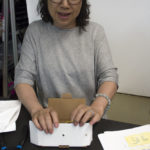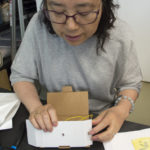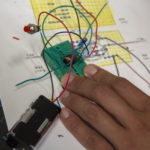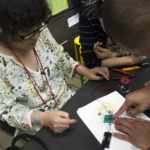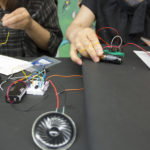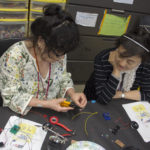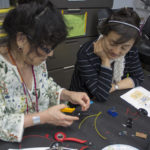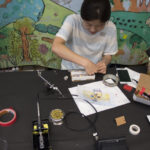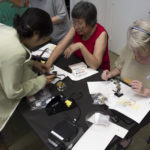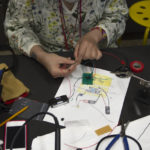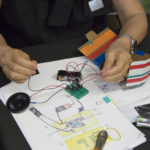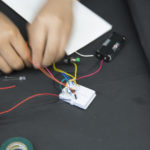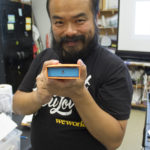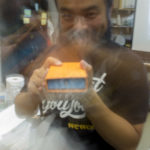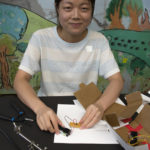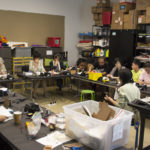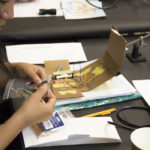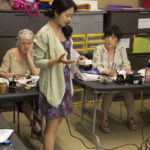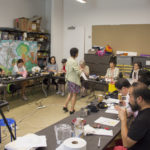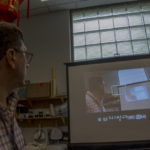The workshop got intense as weeks passed. We finished up the Dark sensitive LED with Photocell project from last week including designing a case.
The class was divided into two groups. The one group expedited into the final project – the interactive sound machine. This group worked independently recalling knowledge from the earlier project. They tested the circuit temporarily with mini bread boards. What is amazing about teaching and learning together is sharing information creating a cooperative atmosphere. Participants who had more experience with electronics started to help others finishing up the Dark Sensitive LED with Photocell. One participant drew her own schematics for it. Some students brought their own case and boxed the circuit (see the #2 video).
In the first week of the workshop, the class discussed learning objectives of Ebb and Flow: Drawing Sound interactive sound machine – learning basics of electronics, designing a case, interacting with the machine as a performance, recording a video. The final project would compose of an object (the sound machine) and a video ( a documentation of gesture and movement) as a multimedia piece on human-object interaction. In a research paper, AniThing Animism Heterogeneous Multiplicity by Van Allen and McVeigh-Schultz (2013), they examined how animistic objects could facilitate the emergence of human creativity. Their another works explored how objects designed to evoke in users a perception of object autonomy could reframe subject-object relationships, particularly in an immersive environment constituted by responsive technology [1]. We will go over why there are so many studies have written about human-object interaction and its significance after we complete the interactive sound machine.
Close to the end, so many participants successfully assembled the sound machine. We demoed together how it works and variation of possible interactive gesture (see the below video). It was a full of awe.
시간이 지남에 따라 워크숍이 열열해진다. 우리는 지난 주에 시작한 어둠에 민감한 LED Photocell과 케이스 디자인프로젝트를 마무리했다
클래스는 두 그룹으로 나뉘었다. 그 한 그룹이 최종 프로젝트–인터렉티브 음향기기에 도움없이 이전의 프로젝트에서 지식을 상기하며 도전을 했다. 참가자들은 케스크용인 미니 회로를 이용하여 회로를 연결성의 완벽함을 테스트했다. 이번주는 놀랍게도 가르치는 것과 배우는 것이 서로 공유되여 협력환경이 자연스럽게 조성된 시간이었다. 전자 회로에 경험을 좀더 많이한 참가자들은 그렇지 못한 분들의 어둠에 민감형 LED Photocell을 끝나 도와 주기 시작했다. 참가자 중 한명은 회로도를 자신이 직접 그려보기까지 했다. 몇몇분들은 자신만의 케이스를 가지고 오셔서 기기를 넣어보기까지 하였다.(#2 비디오).
워크숍 첫째주에 수업의 목적을 설명해 드린봐 있다– 전자의 기초 원리를 배울 것, 케이스 디자인, 소리 기계와 인터렉티브 하는 동장 (행위예술), 비디오 녹화 (다큐멘케이션).최종 프로젝트는 오브제 (음행 기기)와 비디오(몸짓과 움직임 기록)를 통반한 사람과 개체의 상호 작용을 이용한 멀티 미디어 작품을 만드는 것이다. Van Allen과 McVeigh-Schultz 연구 보고서, AniThing animism Heterogeneous Multiplicity (2013)에 의하면, 그들은 어떻게 물활론 (모든 물질은 생명이나 혼, 마음을 가지고 있다고 믿는 자연관)적인 개체가 인간의 창의성의 출현을 촉진할 수 있는지 조사했습니다.그들의 또 다른 연구에서 어떻게 사용자가 생각하는 개제의 자주성이 그 개체의 설계 디자인에 의해 인식이되고 사용자와 개체의 상호작용의 관계를 몰입형 가상환경에서 재구성할수 있는지를 연구하였다[1]. 사용자와 개체의 상호작용에대해 왜 많은 연구가 그것의 중요성에 대해 저술하였는지 워크샵 마지막 시간에 알려드리겠습니다.
많은 참가자들은 성공적으로 사운드 기계를 구성했다. 우리는 함께 소리기기가 어떻게 반응 하는지 직접 테스트를 했다 (세번쨰 비디오). 요번주는 함께 같이하는 경외로운 시간이었다.

